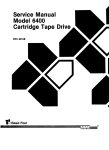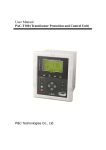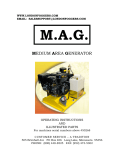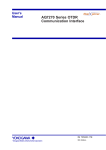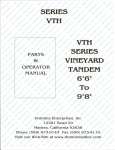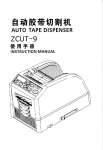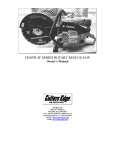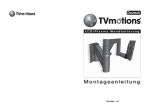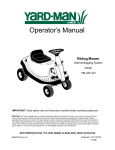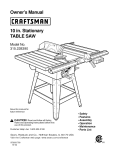Download View Manual
Transcript
WWW.LONDONFOGGERS. COM EMAIL: SALESSUPPORT @ LONDONFOGGERS. COM ULTRA LOW VOLUME AEROSOL GENERATOR O e OPERATION MAINTENANCE AND PARTS Pending CUSTOMER SERVICE-A TRADITION 505 Brimhall Ave PO Box 406 PHONE: (800)448-8525 Long Lake, Minnesota 55356 FAX: (952) 473-5302 INDEX Forward 1 2 3 5 8 9 10 11 11 11 13 14 15 16 16 18 19 20 Specifications Safety Precautions Assembl y/i nsta I I a t .ion Servic Before start-Up Pre-start Check List Start-Up Operation Setting Flow Rate Calibration Spraying Flushing Service Schedule Ma i ntenan ce Air Presur, e Air Pump Belts Engine Oil NOzzle 3) Flushing Air Pump Oil Formulation Filter Air Pump Fi I ters Engine Air Cleaner Battery Spark Plugs Engine Carbon Engine Cool ing Engine Crankcase Breather continued 21 22 22 23 23 "24 INDEX (continued) Maintenance' (continued) Governor Pulsation Tank Pul sation Damper Over Pressure Switch Trouble Shooting Preparation for Schematic Fluid Storage System Wiring Diagram, Wiring Diagram, Cab Control Machine Illustrated Parts Basic Machine Air Pump .J .anuary 1986 FOREWARD The application of insecticides is the predominant method by which man attempts to limit the size of insect populations. Due to economic as well as environmental reasons, it is desirable to treat a given area with the least amount of insecticide that can be made to be effective. The most efficient method is to break up the liquids into aerosols and distribute these fine droplets over the affected area. The fine particles stay suspended for longer periods of time due their size and are distributed more evenly, remaining effective longer. The term U.L.V. is an.abbreviation for the terms Ultra Low Volume. Ultra Low Volume is the designatio.n of the technique of treating areas with relatively small amounts of chemicals in the. aerosol state. These chemicals are usually in a more concentrated state than chemicBls used in other methods of appl i cation. For best results, London Aire ULV Aerosol Generator should be operated and maintained in compliance with the formulation label instructions. .DESCR.'. ION This machine is intended to be vehicle or trailer mounted and is designed to be operated by. the driver of the vehicle"iith the remote control box. SPECIFICATIONS TYPE" Vehicle or trailer mountable non-thermal, U.L.V. (Ultra Low Volume) Cold. fog aerosol generator. ENGINE- Kohler .M.clnxn.cast iron, one. cylinder, 4-cycle, gasoline, 8. h.p., 12v Fuel Consumption regular Or no lead automotive 0.7 .gal/hr.. (2.65 electric start with alternator. AIR PUMP" Positive displacement, 4 cylinder, all cast iron, belt driven, 900 r.p.m. FORMULATION PUMP" iter/hr) displacementpiston pu.mp with adjustable oz./min. (0 to 295.7 ml/min.) 360 horizontal adjustment (azimuth) and 30-60 vertical adjustment (elevation). Positive output from: 0 NOZZLE SYSTEMTANKS" to 10 .corr.osion-resistant, high density po.ly.ethylene, .( fb-cmu l at i on and flushing tanks onlly). Formulation- 15 U.S. Gallons (56.7 Liters) Flushing" .1.5-U.S. Gallons (5.67 Liters).(Optionl) All tanks (11.3 Liters) (mass median diameter) Gasoline" 3.0U.S. Gallons PARTICLE SIZE- 5 to 20 Microns MMD on flow rate and depending LENGTH" pounds (127 kilograms) 42 inches (106 cm) WIDTH: 34 HEIGHT" 30 WEIGHT EMP.TY 280 inches (86 cm) inches (76 cm) v.i-scosity. I. SAFETY PRECAUTIONS WARNING READ AND UNDERSTAND THESE SAFETY PRECAUTIONS BEFORE OPERATING MACHINE. 1. uses gasoline as. the fuel for the precautions commonly applying all int.ernal .combustion engine and Exercise extreme caution observed.. to this volatile fuel should be of spillage gasol.ine. If to avoid spilling occurs, wipe it off and engine. DO NOT attempt the time starting allow evaporation before running. Avoid still machine the is tank while to put fuel in the smoking or open flame .in area when handling gasoline. Never run the unit indoors unless exhaust is vented to outside. These fumes contain carbon monoxide which is colorless and odorless and can be fatal. ENGINE AND FUEL: This mchine NOTE DO NOT OPERATE ENGINE WITHOUT MUFFLER. DO NOT TOUCH HOT MUFFLER, CYLINDERS OR FINS AS CONTACT MAY CUSE BURNS. Except for adjustment DO NOT OPERATE THE ENGINE IF AIR CLEANER OR COVER DIRECTLY OVER THE CARBUETOR AIR INTAKE IS REMOVED. DO NOT RUN THE UNIT IF THE BELT GUARD IS REMOVED. DO NOT TAMPER wITH.GOVERNOR SPRII(GS,. GOVERNOR LINKS OR OTHER PARTS WHICH MAY INCREASE OR DECREASE THE GOVERNED ENGINE SPEED. -2. TheENGINESPEED (RPM) should be check periodically to ensure that it iS o'er'a'ting" orrectly, as the engine affects the air pressur.e... and formulation flow which.affects droplet size. The correct engine speed should be 2700rp.m. plus or minus 150r-pm. 3. 'MACINEDAMAGE. Never A-damaged machine can 4. 'WIND: Operate a machine after it has been hazardous. be very Spraying during windy conditions is damaged. not.usually practical -beCause .the formulation will drift out of the intended area. However, underNO circumstances should spraying into the wind be attempted. This may cause hazardous accumulations of formulation on the machine orcarrying vehicle. SAFETY PRECAUTIONS (continued) 5 EQUIPMENT: In addition to any safety equipment thal- may the type of formulation which is being used', the following items should be with each vehicle which carries this machine during fogging operations" a. Fire Extinguisher, chemical type rated for fuel fires. SAFE,TY be' reqdirel by First Aid Kit. c. Eye Wash Solution. d. Safety Glasses e. Container of Oil Dry Compound f. Gloves rated for high temperature. g. Respirator adequate for formulation b. 6. 7. being used. 'CHILDREN- Many spraying operations are performed in residential areas conlnonly at dusk. This presents the operator with the problem of. children who are attracted to the noise and/or the mist being created. The possible hazard l is in the toxic effect of some formulations, the severity of which depends upon the chemical used, mist density, and the length of time of direct exposure. IT IS THE OPERATOR'S RESPONSIBILITY TO DISCOURAGE ANYONE FROM PLAYING IN THE MIST OR BEING NEAR THE MOVING VEHICLE. FORMI)ILATIONS- Ensure that formulations are applied only in strict om-p)iance with the formulation label as well as local, state, and federal regulations and that these formulations are dispersed only by trained personnel of public health organizations, mosquito abatement districts, pest control operators or other qualified personnel. a. Always comply with any requirements for protective clothing., goggles, gloves, facial masks, or respirators required on the formulation label. b. Do not exceed the dosage set forth on the regist.ration label of the insecticide to be used. Always store formulation in its original labeled container. .c. IN NO WAY IS IT TO BE CONSTRUED THAT THE CHEMICALS AND/OR DOSAGES ARE THE RECOMMENDATION OF LONDON FOG, INC. LONDON FOG, INC. SHALL IN NO EVENT BE LIABLE FOR CONSEQUENTIAL DAMAGES OR CONTINGENT LIABILITIES ARISI.NG OUT OF THE .FAILURE OF ANY AEROSOL GENERATOR OR PART TO OPERATE PROPERLY. I I. 1. ASSEMBLY/INSTALLATION INSTRUCTIONS Uncrate the unit and remove all packing materials. NOTE 2. 3. It is a good idea to retain the original machine shipping carton as well as its inner packing and blocking materials for any future storage and/or shipment which may be required. Place the Remote Control Unit where it will not be damaged while machine is being prepared. Lift the machine onto the vehicle with the discharge end of machine toward the rear the of the vehicle. 4. Pass the Remote control unit through an open window and locate within reach of the person who-wil] be operating the machine. If permanent vehicle installation is desired, the remote control cable can be passed through a small hole in the vehicle cab and then reconnected. Make sure the small hole provides proper protection against wiring damage and is re-sealed to prevent exhaust gases from entering inside of the vehicle. 5. Using the most convenient routing, run the conlrol harness to the connecting support bracket.located on the engine gas tank bracket. Orient the electrical plug on the harness so that the electrical pin locations match the mating pin receptacles in the socket and push the plug firmly into the socket. Push the air line connector into the mati.ng quick connect socket and lock into place. Securely bolt the machine to the vehicle. Correct battery type is Group U1 garden tractor. Use NAPA 8221, Sears 9603 or any equYa!-en.t--measuri.ng 7 3/4. x 5 1./4 x 7 1./4-high. 6. 7. WARNING DANGER POI SON BKrTERIES PRONC.EXPt.OSIVEGASES. KEEP SPARKS, FLAMI, CIGARETI'ES, AWAY.VENTILATE WHEN CHARGING OR USING IN AN ENCLOSED SPACE. BAIIERIES CONTAINStlt.FURICACID WHICH CAUSES SEVERE BURNS. IF ACID CONTACTS EYES, SKIN, OR CLOTHING, F'L'USH WELL WITH WATER. FOR CONTACT WITH EYES, GET INEDIATE MEDICAL TTENTION. KEEP BATTERY AND ACID AWAY FROM CHILDREN AND OTHER P,ERSONS WHO MAY NOT BE AWARE OF DANGERS INVOLVED. ASSEMBLY/INSTALLATION. INSTRUCTIONS (continued) A. Remove batter mounting from. its and place workbench. on a stable B. Remove vent caps from battery. Remove or destroy any sealing device which may have been used to close or restrict the vent opening in the caps. C. Fill each cell of the battery to the top of the separators approved battery electrolyte of 1.265 specific gravity. with NOTE Temperature of battery and electrolyte at the time f filling should be above 60 degreesF. (i5 degreesC.) CAUTI ON Never fill battery in machine as spills will on frame and cause-premature corrosion. D. damage finish 12 volt battery at 30-40 amps until the acid temperature is above 80 degrees-F. (26 degrees-C.) and the hydrometer reading is 1250 or higher. Charge NOTE Both temperature and hydrometer readi.ng requirements must be met. E. After cha.rgi.ng the battery, check acid l evel in all cells and fill each cell withacid to the proper level. .F. Re-install vented caps. .G. Re-install the battery onto machine. Ho Connect Positive (+) cable (leading from the starter switch which i s located on the e.ngi ne switch panel) to the positive (+) post on the battery and tighten bolt. I. Connect the battery and Negative (-) tighten bolt. cable to the Negative (.-) post on the AS S E_MBL Y/I N STALL AT I ON I N STRUCT IONS (continued) CAUTION installing battery, negative sparking anl shorting. required, remove negative a. When (-) cable last to prevent b. When disconnecting is connection first.- c. Reversed polarity can and charging systems. (-) connect the cause damage to the starting NOTE After battery has been initially serviced, only water should be added to restore the liquid level in each cell. Further addition of acid will cause battery failure. 8. Loosen the ball swival joint and.orient the nozzle as required hy the formulation label. Usual set-up is towards the rear and 45 up. Retighten ball joint. III. SERVICE.BEFORE START-UP1. 2. Engine- Servie engine with gasoline and oil as per the accompanyingEngine Operating and Maintenance Instructions. (Engi.'ne may already be serviced with oil.) Air Pump: Before starting, the machine, remove the dipstick and heckoil level. Fill as necessary with SAE 30 nn-dtergent type oil for the first 50 hours of operation. Oil level should never be higher than the upper mark on the dipstick, nor lower than the lower mark. After the 50 hour break in period, the compressor oil should be changed to a synthetic oil such as Anderol 500 or Amsoil Synthetic Reciprocating Compressor oil available locally or from London Fog Inc. (part number 2319, pint or part number 2320, quart) NOTE synthetic type oil is recommended due to the lower maintenance requirements for the air pump and other components. DO NOT mix The oils. 3. 'Drive-belts- Check drive belts which should be in l-i gnment and tight. perfect IV. PRE-START CHECKLIST 1. Verify the 2. that the remote control box is within easy reach of operator. Verify that the nozzle is in the correct position as required spraying operation to be accomplished, and that the ball joint which allows this positioning is tight. Verify that the engine has sufficient fuel and is properly for the 3. Iubricated. 4. 5. 6. Verify that the air pump has been serviced. Inspect all hoses for abnormal conditions. Verify that no foreign objects or tools have been left in or about the machine. 7. 8. 9. Verify that sufficient amount of formulation is in the tank and that the tank filling plug is tight, and that the air vent hole (located on the underside of the tank handle) is not obstructed. Verify that the battery is mounted securely and cable connections are proper and tight. Verify that all safety equipment is in place and is in proper working order. CAUTI ON Before proceeding with any spraying operation, the operator should be thoroughly famil.iar with starti.ng and stopping the machine and with all the operating controls. If you are operating the machine for the first time, exercise the machine through its full operational sequences from a position of full visibility of the machine before operating the machine fully remote. This is also a good idea for experienced operators who may be operating a new machine or who may be reactivating a machine after repairs or a period of inactivity. Refer to the operation sect:i.on for starting and stopping instructions. V. START UP NOTE On machines equipped with remote start, the engine may be started from either the engine or the remote control box. When cold, choking may be required on the initial start-up. Verify that the spray On-Off switch on the remote control box is in the OFF position. Place the Ignition On-Off switch on the remote control box into the oN stion and the ignition key on engine t the "ON" position. The engine may now be started from either the remote control box with the START swtch or from the engine by turning e key t e start position. NOTE The best starter life is provided by using short cranking cycles of several seconds: prolonged cranking can damage the starter motor if cranked more than 15 seconds per minute. CAUTION On each start up, be sure the formulation pump does not run dry. If there is no formulation in the lines, immediately turn on the spray nozzle so that formulation is drawn through the system. The spray may be turned off as soon as formulation reaches the nozzle. 10 Vl. OPERATION Read this complete OPERATION section and the section on SAFETY PRECAUTIONS before taring the machine. For first time operation the sections on INSTALLATION, SERVICE BEFORE STARTUP, and PRESTART CHECKUST must be performed before proceeding with operation. When operating this machine for the first time, move to an uncongested and well ventilated work area in open rea away from flammable materials. WARNING READ THE SECTION ON SAFETY PRECAUTIONS BEFORE PREPARING TO DISPENSE FORMULATION. RED AND THOROUGHLY UNDERSTAND ALL INFORMATION, CAUTIONS AND WARNINGS ON THE FORMULATION LABEL WHICH IVlAY AFFECT PERSONAL SAFETY. KNOW ANY DANGERS OF THE SOLUTION USED AND KNOW WHAT TO DO IN CASE OF AN ACCIDENT INVOLVING THE SOLUTION. ALWAYS USE THE APPROPRIATE SAFETY EQUIPMENT AND DRESS ACCORDING TO THE CHEMICAL FORMULATION WHICH IS BEING USED. DO NOT USE ANY SUBSTANCES FROM. UNMARKED CONTAINERS OR FROM CONTAINERS WITH OBVIOUSLY ALTERED LABELS. READ AND FOLLOW THE INSTRUCTIONS ON THE CHEMICAL SOLUTION LABEL FOR ULV SPRAYING OF THE SOLUTION. DO NOT SPRAY NEAR AN OPEN FLAME OR HOT MATERIALS. DO NOT LEAVE THE MACHINE UNATTENDED. 1. CAUBRATION: SETTING THE FLOW RATE .C.A.UTION Before calibration, be sure the machine fluid lines are free from any air bubbles. Ort initial start-up, it may be helpful to temporarily move the pump pointer to a high scale reading to get the system pdmed and the lines purged of any air bubbles. 11 OPERATION (continued) 'SPRAYING CAUTION Before dispensing insecticide, be certain that no one is present in the area of the nozzle or aerosol dispersion area. To dispense insecticide with the ULV machine running, move the flow control on/off nozzle switch (cab control) to the ON position. The green indicator light should come on. The air pressure gauge on the cab control panel should read between 75 and 85 pound per square inch pressure. If this pressure is not present, shut off the flow control switch and see Air Pressure Instructions. DO NOT dispense insecticide until the air pressure problem is corrected. OPERATION (continued) The fluid pump system is calrated to the graduated scale on the pump at the London Fog factory, ff any major deviation in the flow rate occum, first check the other components in the system (such as strainers, dtings, etc.). Check tr air bubbl in e son side t e ne 11 e pressure side. Check for tluid leaks in the pressure side of the lines. Minor deviations not created by equipment malfunctions, should they occur, may be recalibrated by measuring the flow and adjusting the pump mering pointer unll e desired flow obined. Td measure the flow, disconnect the fluid line from the aerosol nozzle. Pice e dconneetcl line into an empt ntainer. Start the pump. Wdh the cab panel flow control switch turned on, fluid will pumped rough e disnneed line iro he rNner. Move the disconnected line from the container to a measuring beaker for a measured arrunt t me I'eferab using a Nop watch. Compare the measurPamount to the flow desired or to the pump scale. Adjust or lock the pump pointer as may be required. Be sure to replace all lines and fittings after calibrating. The following are rough estimates of flow rates using very light mineral oil. Alwa_vs r,librte to establish correct.flow ..etes for the chemical or insecticide to be used. Flow R.pte (mllne_l 95 150 25O 320 410 475 Flow Rate (oz./minute1 3 5 8.40 10 14.20 16 13 Scale. Settinq .50 1.00 1.50 2.00 2.50 3.00 OPERATION (continued) FINISHED OpERATION When the spraying operation is complete, the unit must be flushed in accordance with "FLUSHING SYSTEM" section of this manual. 4. FLUSHING A StorageWhen flushing for storage, drain the formulation tank and place flushing fluid in the main formulation tank. Run the generator with the nozzle solenoid valve in both the ON and OFF positions to clean all lines. Drain any remaining flushing solution from.formulation tank. Repeat Before as Bo necessary. After each.use 1. 2. (without Built-In Flusher With the aerosol generator nozzle. running, accessory)turn ON the spray At the formulation filter (large white nylon assembly), disconnect the larger (3/8") fluid line which runs-from the filter to the Posi-Drive pump. Place this line in "a container of flushing solution. Run the unit until the flushing fluid has cleaned the lines, pump and nozzle. NOTE More pump rapid flushi.ng may be accomplished by moving the pointer to a high flow rate. setti.ng. CAIJTION flushing the generator, the sproychMUST be turned ON (at the cab control) so that the mach----"ne is discharging aerosol. When 3. CQ Reconnect the fluid line to the formulation filter. Tighten very finger tigh t Do not use wrenches. After each use (with Built-In Flusher)- Use same method as B above except in step #2, just turn the flush valve to the F-LUSH position. Eliminate step #3 above. i4 VI I. SERVICE SCHEDULE _Daily ITEM TO BE SERVICED ltozzle /i r 'lesure Interval 25 ,so, l,,Soo X X X X X Calibration Check.Al r Pump Oi I .heck, Air P,u.p. Belts Check Engine 0ii Cl ean Nozzle Flush Change Air Pump Oi 1 X Change En.gine 0.!1_, Clean Formulation Filter ..Cle..an Air. Pump_Air F.i!t,ers Replace Engine Air Clean,er_E1ement Check Batter X X Cck/Gap .Sark PIu_g .D.ecarbo.n i ze E.ngi ne X Service Breaker-Points Clean Engine Cooli.ng Fins Check/Set Engine Timing Check Valve Clearances Check AI I F.it.t.ings Check POsi-Dr|:.v,e Pump. Belt X X Ch.e..c.k Engine-,Flywheel _.sc_r..e_en X Check Engine Crankcase Breather Ch.eck/Set Gover_nor.. Drain Airp___ump Pulsation Chamber .Check, Pulsa,tl,on D,.amper A/R Over-Pressure Cut-Off Switch 15 VI II. -MAINTENANCE io AI R PRESSURES A Low Air Pressure- 1. Air pressure to air tip 75-85 psi, as measured air pressure gauge on remote control Panel. by Engine should run at 2700 rpm and air pump at 925 rpm. A loose or slipping belt can cause l.oss of air pump rpm. Malfunctioning engine or govern.or out of. adjustment can cause improper engine rpm. 3. Air .leaks can cause reduced pressure even though engine and air pump are operating OK. Air leak at or around air-fluid nozzle tip or junction of nozzle with the nozzle body, can cause reduced pressure. Be sure that teflon gasket (part no. 1013) which seals the mating surfaces between the air-fluid nozzle and nozzle body is in good condition and properly installed. Be sure that air fluid nozzle is properly tensioned against the teflon gasket. Air leaks at any of the air line joints 2. can also cause reduced pressure. as indicated at remote control panel can poor atomization resulti.ng in too large fluid Low pressure cause droplets. NOTE If nozzle air pressure is below normal on Daily Check-UP, check for air leaks at all joints. Air leaks can be detected by holding the hand or fingers close to the various joints and feeling if air under pressure is blown .against the hand or fi.ngers. Low nozzle air pressure may also be cuased by failure...to close the pulsation chamber drain valve after use for draining. High Air Pressure" If air pressure exceeds normal setti.ng and the engine rpm has not increased above normal, a partial blockage may have occured in the air cap of the aerosol nozzle assembly. To clean air cap (and fluid nozzle when necessary) use acetone as a solvent for gum orvarnish and wipe all surfaces clean with a r.ag. Carefully clean the orifices in the air cap with toothp.icks and acetone. Blow through these orifices with compressed air if available. While air cap is. removed, wipe clean all exposed surfaces of the fluid nozzle. 16 MAINTENANCE (continued) that any deposit or build-up is wiped clean from the snout of the fluid nozzle, where it projects through the center orifice of the air cap. Be sure projecting While air cap is removed, also inspect the three holes in the fluid nozzle for deposits or internal build-up. Cleaning of these holes (and removal of the fluid nozzle) is seldom required due to the large area in relation to the air flow area through the air cap. To clean the holes in the fluid nozzle, remove nozzle and clean the three holes with a toothpick and acetone. Also clean all exposed surfaces with a rag and acetone-. At the same time, clean the circular air groove in the back of the fluid nozzle. Blow through the three holes with compressed, air, if available. All nozzle assembly parts should be soaked in acetone if necessary to soften gum, varnish or other desposits. to over-tighten the fluid nozzle against its teflon to avoid extruding or damaging this gasket. Replace teflon gasket if worn.or, damaged in any way. Use care not so as gasket Unduly high pressures can be caus.ed of 900 rpm, which is unlikely. 17 by air pump turning in excess MAINTENANCE (continued) 2. AIR PUMP Check oil level daily, Oil level must never be higher than the upper mark on dip rod nor lower than lower mark. Use Amsoil Synthetic Reciprocating Compressor Oil, Anderol 500 Synthetic Reciprocating Compressor Lubricant or SAE 30 nondetergent petroleum based oil. NOTE The synt.hetic type oil is recommended due requirements for the air pump maintenance to the lower and other components, OiPS'I"ICK OIPSTICK TOP MARK U COM P R ESSO R 18 BOTTOM MARK MAINTENANCE (continued) BELTS perfect alignment and Check drive belts which should be in enough to slip. neither excessively tight nor loose 5/16"" ALIGNM.-NT GAGE COMPRESSOR iNCORRECT INCORRECT CORRECT i_ 3/8' .- made An alignment gage can be metal froma piece of scrapline up or the wood and be used to pul I eys. BOLT PLAT E BELT TENSIONER COMPRESSOR TENSIONER MOUNTING SCREW. PL ATE 19 MAINTENANCE (continued) Check .ngi ne PLUG oi I. .DIPSTICK CYLINDER Before checking oil level, clean area around dipstick and oil fill areas to prevent dirt from entering into en- gine. Oil sho.uld always be checked while engine is level. With threaded plug-type dipstick, remove and wipe oil off--reinsert, but do not turn plug in. To check oil level, shoulder plug on top of hole. After checking, again turn plug all the way into crankcase. CAUTION: DO NOT operate engine with oil level below "L" mark or over the "F*' mark. Air Temperature Oil Viscosity Also read Oil Change under Maintenance Instructions. Above 320 F (0 C) SAE-30 011 Type, Below 32 F (00 C) SAE 5W-20 or SAE 5W-30 Use oil meeting the requirements of SAE service class SC, SD. SE, and SF. Select oil viscosity based on the air temperature at the time of operation, as shown. Do not use multi-viscosity oils above 32F as considerable increases in oil Use straight weight oils as specified. consumption and combustion deposits will result. Clean Air/Fluid nozzles. See instPuctions under "Air Pressure" Be paragraph #1 FLUSHING Flush out the chemical system with soap and water or other suitable flushing fluid after each use. Always flush thoroughly prior to down time or storage. See Operation Section for 20 flushing instructions. MAINTENANCE (continued) 7. DIPSTICK Change Air Pump OilChange the air pump crankcase oil. Use Amsoil Synthetic Reciprocating Compressor Oil or Anerol 500 Reciprocating Compressor Lubricant, or SAE 30 Non-Detergent Oil. DRAIN Change Engine Change engine Use detergent Oil- COMPR ESSO R Crankcase oil after each 25 hours of oil API service classification SC. operation. On a new engine, change oil after the first 5 hours of operation and then every 25 operating hours thereafter. Change oil more frequently under dirty, dusty conditions. Drain oil while engine is still warm from operation and it flows freely, carrying away more impurities. (See engine identification illustration for location of drain plug.) After draining oil, reinstall drain plug. Select proper viscosity oil and fill to "F" mark on dipstick as opposed to adding a given quantity of oil. Always check level on dipstick before adding more oil. Engine must be level when checking or changing oil. Air Temperature Above 320 F (0 C) Below 32" F ((7' C) SHOULDER TYPE DIPSTICK OIL DRAIN. Oil Viscosity SAE-30 OIL PAN SAE 5W-20 or SAE 5W-30 21 MAINTENANCE (continued) 9. Clean Formulation Filtera fine mesh filter screen located in the large, cylindrical white nylon housing. This screen can be removed for inspection and/or cleaning by manually unscrewing the cap. When reassembling, be sure that the sealing gasket is properly positioned so as to avoid damage-cused by pinching. Tighten housing only hand tight during replacement; do not There is use tool s. If the screen should become clogged, maximum formulation flow rate will not be attained, FILTER CAP FI LTE R CAP FILTER SCREEN F ILTER B SC 10. Check Ai Pup fi ItersThe air intake filters in the air PumP should be cleaned or replaced every IO0 hours, or sooner if dirty. . 22 BRACKET E LEMEIITS COMPRESSOR CYLINDER HEAD MAINTENANCE (continued) Clean or replace Engine Air Cleaner Element- engine is equipped with a drycleaner element every 50 operating hours and replace when dirty or damaged. Check more frequently under extremely dirty, dusty conditions. This LIGHT type air cleaner element. Inspect air FI LTE R ELEMENT MOUNTING.... SCREW AIR FILTER COVER Check Battery- I Test the FILTER ELEMENT " AIR FILTER MOUNTING GASKE'r battery with a volt-ohmmeter. Connect the positive (+) meter lead to the positive (+) battery pole. Connect the negative (-) meter lead to the negative (-) battery pole and set the meter on volts. If the meter reads 11.5 to"12 volts the battery is OK. If the meter reads less than 11.5 volts; check the specific gravity of the electrolyte. 23 MAINTENANCE (continued) 2. 3. Remove., the cell caps and check the elec- trolyte level. Add distilled water if necessary. Check the specific gravity. If the specific gravity is between 1.250 and 1.280, the battery cell being tested is OK.. If the specific gravity is between 1 225 and 1.250, the battery cell being tested is still in fair condition. If the specific gravity is below 1.150 in any one cell, replace the battery. If the specific gravity in one cell is 0.050 more or less than the other cells and charging does not bring the charge to a 50% charge, replace the battery. Charge the battery- (a) (b) If the battery If the battery holds does. not hold machine. 13. a a charge, HYDROMETER j CELL CAP TTER charge, replace return the the battery battery. to the Check/Gap Spark PlugCheck spark plug visually. Replace it if the following conditions exist. WORN ELECT OIL FOULING SPARK PLUG DEPOSIT BUI LDUP G AP 0.025" BENT (0.64MM) ELECTRODE, CRACK. 24 I MAINTENANCE (continued) Decarbonizing EngineRemove engine cylinder head, scrape out carbon deposits, install new cylinder head gasket, install head and t.ighten bolts in proper sequence. See Torque Specifications page at ehd of this section. Clean Engine Cooling.Fins Every 50 operating hours (more often if conditions require) remove cooling shrouds and clean cooling fins. Also clean external surfaces of your engine of dust, dirt and oil which can contribute to improper cooling. DO NOT operate engine with cooling shrouds removed--this will caust overheating and engine damage. Check/Set Engine Timing Refer to Engine Service Manual" or Authorized Service Deler. 25 MAINTENANCE (continued) Tappe Clearances: Refer to Engine Service Manual or Authorized Service Dealer. Check All Fittings" Check all hoses and fittings for cracks, leaks, and/or looseness. Tighten plastic fittings hand tight only. Check Valve Check Engine Flywheel Screen: B LOW E R HOUSING Make sure the air intake screen is clean and unobstructed. If debris builds up on screen during engine operation. STOP engine immediately can cause engine overheating. and clean off. An obstructed screen SCREEN CHECK/SET RPM: NOTE The belts should be connected to the pulleys while A B. checking the engine speed. Check the engine operating speed with a hand-held tachometer. The engine should run at 2700 rpm. If the speed is not 2700 rpm, adjust the throttle. Adjust the engine speed to 2700 rpm. Move throttle lever up to decrease rpm or down to increase engine speed. 26 MAINTENANCE (continued) PumpDrain Pulsation Tank by opening drain valve with rag placed underneath to catch drainings. This can conveniently be done when starting up at the beginning f the day. Be sure to close drain valve after draining is completed. Drain Pulsation Tank on Air .PULSATION TANK AI R HOSE OPEN PULSATIC TANK DRAIN VALVE 27 MAINTENANCE (continued) . pulsation Damper: The piston type metering pump tends to deliver a slightly pulsating flow.of insecticide. For best aerosol particle size, a more even (non-pulsating) flow is desirable. A small air chamber type pulsation damper is located in the metering pump pressure outlet line, between the pump and the aerosol discharge nozzle. It is a white nylon assembly with an air dome that can be unscrewed by hand for inspection. It has a gasket which seals the joint Check between the air dome and the lower section. The air dome should be checked periodically to make sure that it has not become filled with insecticide. If the dome has no air in it, it will not function as a pulsation damper. Be careful to position the gasket ring carefully, so as to avoid pinching, when replacing the air dome. O GASKET 28 MAINTENANCE (continued) OVER-PRESSURE ENGINE CUTOFF SWITCH: The over-pressure cutoff switch system isolated on top of the pulse dampener in the control box. This system monitors the fluid line pressure between the formulation pump and the nozzle. If at any time the fluid line pressure exceeds a factory preset point, the cutoff switch will turn the pump off before damage occurs to the pump or other machine components. Some problems that may cause the switch to turn the pump off are: A! B= C. Ol Eo plugged fluid lines. Defective or plugged solenoid valve. Plugged orifice in fluid nozzle. Nozzle body plugged in fluid carrying portion. Teflon nozzle gasket leaking air into fluid carrying portion of Kinked or nozzle. On occasions where the blockage or problem keeps the fluid line pressur right at the cutoff I:int, pump surging will oeeur indicating that the cutoff switch is continually tuming the pump off and on as the pressure slightb/increases and decreases. When-ever this or complete pump cutoff occurs, be sure to find and remedy the cause before trying to continue operation. 29 TROUBLE SHOOTING SYHPT( le Starter.fails to crank engtne POSSIBLE CAUSE CORRECTIVE ACTION Battery able connections dtrty damged. be Dead battery. loose, or Starter solenotd defective loose connections. d. DefectlYe starter swttch. or Starter defective. f. Air pump locked up. e. 2. Engine hard to start. to stsrt or fails a. START-STOP switch stop posttton or on engine tn faulty. b. Hachtne ON-OFF switch lecated on remote control box tn OFF posttton or faulty. or contaatnated c. No fuel e. Spark plugs faulty. d. Clogged fuel filter. fuel. f. Fuel Ixnq) or carburetor defective g. Temlnals loose or wtrtng defective. h. Spark plug wire disconnected 3. 4. Engtne mtsses Engine knocks or.runs erratically a. Sp;rk plug faulty b. Spark plug wtre disconnected c. Contaetnated fuel d. Clogged fuel ftlter e. Crburetor aounttn9 gasket leaks f. Cylinder head gasket leaks develops noise or ae Clean & ttghten cable connections. Replace a damged cable. b. Replace or charge battery. c. Replace solenotd& tighten connections. d. Check starter button on eng|ne and/or starter switch on remote control box. e. Replace starter. f. Inspect A|r pump for rotat|on. a. Place swttch tn start position, replace faulty sw|tch. be Place swttch tn ON postton, replace faulty swi tch. Add fuel or clean tank and refuel. d. Clean.or replace fuel filter. e. Clean or replace plugs. f. Consult nearest englne service center. g. Tighten loose tem|nals, replace wtrlng. . defective Connect spark plug wtre. . Clean or replace Connect spark plug wtre Replace fuel Clean or replace Tighten halts, replace gasket tf necessary. f. Ttghten cyltnder head bolts. F111 o|1 to proper level, after otl ftll if no|se continues Crankcase otl low a. Huffier clogged b. Clean consult neares.t engine service center Fly.eel smoothly loose dirty of or replace or adjust carburetor c. Consult nearest englne service center a. Clean 5. Engine wtll 6. Engine overheats Crankcase oil low b. Air shroud clogged c. Exhaust restricted Add otl to proper level b. Clean or replace air shroud c. Replace muffler 7. Eng|ne backfires a. Gasoline mixture to lean b. Defective spark plugs a. c. c. adjust carburetor Clean, adjust and/or replace Fee, clean and adjust valve a. Adjust valve 8. not run Engtne COmpression a. Carburetor adjustment or out a. Low tnlet valves stick|rig Valve clearance improper b. Defective cyltnder head c. Defect valves or piston rings d. Cylinder head 9asker leaks a. a. b. b. c. d. Consult nearest engtne service center Consult nearest engtne service center T|ghten head bolts or replace 9asker IX. TROUBLE SHOOTING (continue'd) SYHPTOHS Engtne does not dellver full poer Engine stops suddenly Carburetor choke valve closed b. Air cleaner dirty c. Carburetor defective d, Exhaust restr|cted a. a. b. c. d. e. f. g. Pump w111 not operate whtle engtne is running Air !. Air CORRECTIVE ACT ION POSSZBLE CAUSE partly Ignition switch faulty Fuel system has dirt, water gu Defective choke Carburetor defective Atr pump locked up Fuel pump. defective d. I. Posf-Drfve Pump output runs but no Faulty w|ring Clean, adjust Replace Vachtne not turned ON b. Defective swttch a. Lamp defective Leak tn suction line b. Out of fomulatJon not replace Replace |gn|tJon switch. b. Clean fuel tank, link & check fuel f| ter c. Inspect choke d. Clean or replace e. Inspect air pump for rotation. f. Clean or replace g. Tighten loose terminal, replace a. b. Consult a. Turn b. open|ng a. b. c. wiring Check belts and belt tenslon Consult factory a. c. a. Output solenotd or muffler defective Defective or loose bels b. Gears tn blower damaged c. choke. a. or a. c. Adjust b. Service air cleaner c. Pump makes excessive nolse I. Output light not .1tt when outpu -switch |s in ON position a. factory on !gn!tion sw tch Replace switch. Swttch may temporarily shorted across temtna.ls for test Replace bulb Check 1tries, tighten Check that both fonnulat|o tank and flush tank have solutlon in them Check voltage at connector which 9oes to solenoid. Should be 12 volts. ]f not, check for voltage at control panel. d. e. Fomulatton filter gasket ptnched Flow control lever |s set to wrong stde f. Ftlter plugged g. Pump defect d. Replace gasket e. Hove flow lever to correct f. g. 31 be position Clean or replace V|sually check pump for rotat|on and piston movement X. PREPARATION FOR STORAGE 1. 2. ou,t chemical system thoroughly. If the engine is to be out of service for approximately two months or more, use the following storage procedure" Drain oil from crankcase while engine is still warm Ao from operation. Refill engine to "F" mark on dipstick with proper viscosity oil. Drain fuel tank and carburetor (or run engine until Bo Flush tank is C empty). Remove spark plug and add a tablespoon of engine oil into the spark PlUg hole. Install plug, but do not connect plug lead. Crank engine slowly 2 to 3 re- volutions.Do E. Clean exterior surfaces of Spread of Fa a engine Store in light film over prevent rust. clean, dry place. to a of oil engine. any exposed metal surfaces FLUID SYSTEMS DIAGRAM (Magnum Engine) NOZZLE 3-WAY ELECTRIC SOLENOID VALVE PULS ATION DAMPER FORMULATION PUMP FILTER. FORMULATION TANK NOT. 3 /LLU.STRATED PARTS Section I Basic Machine Parts Section I I Air compressor 37 parts XK MODELS XID BEFORE 1997 WITH METAL GAS TANK ON ENGINE (SERIAL # AND BELOW) REFERENCE NUMBER 2 PART _QUANT!T DF-"RIFrlON_ ENGINE, 8HP, K SERIES 1 I 3089A 3001 2172 2173 2160A POLYTANK ASSEMBLY MOUN'IG BASE BRACE PUMP IV,Y GAS TANK 3113 3113.1 3104 3106 PARTITION, TRAY PARTITION, TRAY I 4 II 12 13 14 B,ER_=__ 2161 3036 4019 3002. 3112 I COMPRFSOR BATTERY BOX BELT GUARD TRAY, POLYTANK CROSS RAIL CROSS RAIL PLATE NUMBER 1 Xl 1997 AND LATER WITH MOLDED PLASTIC GAS TANK ON ENGINE AND UP) (SERIAL # PART DESCRIFrlON NUMBER 2161.I ENGINE 8 HP, MAGNUM SAME SAME SAME SAME SAME SAME NOT REQUIRED NOT REQ SAME SAME SAME SAME XK MODELS XKPD BEFORE 1997 WITH METAL GAS TANK ON ENGINE (SmAL # ND ELOW) REFERENCE NUMBER QUA 1 20" 1 10 11 12 4 23" 14 16 17 lg 19 20 21 4 2" 1 1 1 2 24 6" PART ER 3024 2158 ST-9.31 2070.2 3019 DRIVE KEY, I/4 X 1/4 X 1/4 SAME SAME SAME SAME SAME 3017 2004.1 ST-9.29 2208 3034 BUSHING, 3/4 X I/4 TEE FITTING, 1/4 SERIAL NUMBER TAG NOT REQUIRED SAME N-7702818 ST.9.29 3000 3004 2184.1 POP RIVET 1/4" POLYFLOW, 44P BELT TENSIONER NUT PLATE COUPLING, FEMALE SAME NOT REQUIRED SAME SAME SAME 2188 3114 ST-2.29 2226 ST-9.31 ELECIRICAL SOCKET CONNECTION PANEL 8 X 3/8 HEX WASHER HEAD FUEL VALVE !/4" HI TEMP HOSE HOT REQUIRED SOT LURED SPACER, BELT GUARD 10-32 X 1/2 PHLPS PAN HEAD 5/16 X 8 X 2 1/4 HEX HEAD BOLT 5/16 SAE FLATWASHER 5/16- 24 X 1/4 HEX HEAD BOLT SAME NOT REQUIRED SAME SAME SAME 20.i'25 2201 3025 4 1997 AND LATER WITH MOLDED rtSTIC GAS TANK O ENGE (SERIAL # AND UP) DESCRIPTION ELC SS GAS TANK S'IRAP SBArEXTESO FLYWHEEL SCREEN PULLEY K-236938 2 6 PART NUMBER PLATE NUMBER BUSHING I/4" HI TEMP HOSE BATTERY CABLE, POSITIVE HOSE BARB, I/4 X 1/4 HOSE CLAMP 1/4" POLYFLOW, 44P NOT REQUIRED ._._ OT PQUn) NOT REQUIRED NOT REQ SAME SAME SAME 26 2'7 2 2 29 30 10 4 2192 ST-3.09 ST-5.51 ST-5.22 ST-5.08 31 32 9 17 4 9 4 ST-5.01 ST-5.26 ST-5.43 ST-5.05 ST-5.01 5/16 24 HEX NUT 5/16 IJ3CKWASHER 5/16-18 X 1/4 HEX HEAD BOLT 5/16- 24 X 3/4 tIEX HEAD BOLT 5/16 24 HEX NUT SAME SAME SAME SAME SAME 10 10 10 I0 1 ST4.07 ST4.01 ST4.50 ST4.49 2263 I/4- 28 X 5/8 tIEX HEAD BOLT 1/4 28 HEX NUT I/4 SAE FLATWASHER I/4 IX)CKWASHER SAME SAME SAME SAME NOT REQUIRED 1 2261 2250.1 2246 2247 ST-3.26 WIRE ASSEMBLY OVER PRFSURE SWITCH MOUNT, SWITCH 10- 24 X 1/4 SET SCREW 2171 FEMALE ELBOW, 1/4 X 1/4 X 90 DEG. NOT REQUIRED NOT REQUIRED 1/4 20 X 2 HEX HEAD BOLT 34 36 38 39 4O 41 42 43 44 46 4"/ ST-4.2 SHRINK TUBE WIRE ASSEMBLY SAME SAME qOT REQtnRED NOTED D..,CRIPTO.N XK MODELS PLATE NUMBER 3 XKPD BEFORE 1997 WITH METAL GAS TANK ON ENGINE AND BELOW) (SERIAL # RIRENCE ]tBER QUANTITY 2 2 I 4 5 I 6 '7 $ 9 10 i 13 14 15 16 17 '18 19 2O (t) (I) 1 21 22 23 24 25 2* I* 1" 26 27 28 29 30 1" 31 32 33 34 35 I* 1" I* I* 36 DRIVEBELT 259.1 2100.1 3016.1 1" LOC I" BLACK STREET ELBOW, 90 DEG. X CLOSE BLACK STEEL NIPPLE K-2304 10 MUFFLER 2112 3015 TY-RAP, DOUBLE 3020 302 2227 2228 1011 1012 1013 ! 1" I* * 1" I DESCRIPTION 3027 3014 139 1022 I1 12 CONSISTS OF: PART NUMBER 1997 AND LATER WITH MOLDED PLASTIC GAS TANK ON ENGINE (s PART ER DESCRIPTION SAME SAME SAM SAME SAME 3/4 X I/2 90 DEG REDUCING ELBOW SAME SAME I/2 X 6 BLACK STEEL NIPPLE SAME I/2 X 1/2 STEEL NIPPLE SEPARATOR ASSEMBLY, COMPLETE SAME I/2 X 90 DEG. BRASS STREET ELBOW SAME SAME BALLJOINT SAME BALLIOINT, MALE HALF SAME BALI.JOINT, FEMALE HALF SAME 1/2 MALE ELBOW, BRASS SAME BODY NOZ2LE ALUMINUM SAME TEFLON GASKET 3022 3023 1010 203O 2025.1 FLUID NOZZLE AIR CAP NOZZLE RING 1/8 X CLOSE S.S. NIPPLE 3 WAY SOLENOID VALVE W/O COIL (PART OF 2025.1A) SAME SAME SAME SAME SAME 2106 BRACKET 1027 I000.I CONNECTOR W/NUT VITON GASKET STUD SAME 170 SAME SAME SAME 1043 1002 D uP) FILTER ELEMENT SAME SAME SAME SAME SAME 1001 048 1041 1044 1045 STUD GASKET RETAINING NUT 1046 ST-6.12 1042 1047 2025.2A BAFFLE 318 24 HEX JAM NUT PIPE PLUG DRAIN COCK 3 WAY SOL. VALVE WITH COIL SAME SAME SAME 2067,1 SOLENOID COIL ONLY SAME CAP, ALUMINUM BOWL BOTTOM 1/8 PIPE PLUG SAME SAME (PART OF 2025.2A) REFERENCE NUMBERS 23-34 ARE PARTS FOR COMPLETE SEPARATOR ASSEMBLY (PART NUMBER 1022, REFERENCE NUMBER I0) XK MODELS XKPD BEFORE 1997 'WITH METAL GAS TANK ON ENGINE (SERIAL # P,LFERENCE NUMBER AND BELOW) PART QUANTIT.Y ,_NUMBER 2178.1 2177 2198 2176A DESCRIPTION LID WITH HOLE (ON MACHINES SER #1200 AND UP) P BOX BASE TI BELT P ASSEMBLY 4O40 PLATE NUMBER 4 1997 AND LATER WITH MOLDED PLASTIC GAS TANK ON ENGINE (SERIAL # AND UP) PART NUMBER NOT REQ. DESCRIPTION NOT REQ. NOT REQ. 2176.ZA PUMP ASSEMBLY WITH MOTOR NOT REQ.. (ON MACHINES SER # 1200 AND UP) 4041 STUD RETAINER NOT REQ. (ON MACHINES SER # 1200 AND UP) NOT REQ. 13 2183 2230 2199 RECEPTACLE (ON MACHINES SER # 1200 AND UP) PUMP BOX LID BELT GUARD BRACKET (ON MACHINES SER # 1200 AND UP) CLAMP, COVER ^SSEMBLY PUMP (pART OF 2 6A) LOCKING PLATE (PART OF 2176A) GASKET SET (PART OF 2176A) PULLEY 16 1'7 18 2200.2 ST-3.18 ST-3.16 ST-3.13 ST-3.09 PULLEY 10-32 X 1/4 SOCKET CAP 10-32 X SOCKET CAP 10-32 X 7/8 PHLPS PAN HEAD 10-32 X I/2 PHLPS PAN HEAD NOT REQ. NOT REQ. NOT REQ. NOT REQ. NOT REQ. 2187 ST-3.02 ST-3.03 WASHER BASE WING NUT 10-32 HEX NUT 10-32 FLEX LOCKNUT # 10 SAE FLATWASI-IER # 10 HI COLLAR IDCKWASHER NOT REQ. NOT REQ. NOT REQ. NOT REQ. NOT REQ. WASHER, PUMPMOUNT NOT REQ. 4187 4204 4039 2178 2174 4021 2179 2237 19 2O 21 22 23 24 25 26 NOT SHOWN NOT SHOWN ST-3.20 ST-3.22 2194 NOT REQ. NOT REQ. NOT REQ. NOT REQ. NOT REQ. NOT REQ. 2237.2 PUMP HEAD ASSEMBLY (PART OF 2 76.2A) NOT REQ. 2230.1 GASKET SET (PART OF 2176.2A) NOT REQ. VIBRATION MOUNT- 4 ELEC'IRIC IN LINE RESISTOR plate 5 XK MODELS PLATE NUMBER 5 XKPD BEFORE 1997 WITH METAL GAS TANK ON ENGINE (SERIAL # FERENCE NUMBER PART NUMBER i072.2 1 2 24 13' * 12.5' * 4 5 ST-10.12 ST-9.38 2205 2206 2075 6 AND BELOW) 1997 AND LATER WITH MOLDED PLASTIC GAS TANK ON ENGINE (SL # PART DESCRiION WIRE/AIR HARNESS CAB CON'IOL, COMI'LETE 16GA. 4 COND. WIRE 1/4 GREY HOSE COVER, BOX BACK, BOX DESCRIFrION OT REQ. 2224.! ST-9.39 SAME 2205.3 2206.2 SAME SAME NOT REQ. 1199.1 9 10 2 1 2196 2076.1 PRESSURE GAUGE DECAL SPACER SWITCH il 12 13 14 1 2197.1 lAMP SOCKET 1 1 1 2107.1 2197.2 2076 2207 BULB, GREEN LENS, GREEN 8" ST-I0.03 ST-2.41 16 GA. WIRE, BLACK BRACKET BULB, PANEL LIGHT 8 X 3/8 PHLPS FLAT HEAD 8-32 X 3/8 PHLPS TRUSS HEAD NOT REQ. SAME HOT REQ. SAME SAME ST-10.01 ST-10.02 2111.1 22 GA. WIRE, YELLOW 22 GA. WIRE, RED TY-RAP NOT REQ. N-723104 POP RIVET SLIDE TERMINAL NOT REQ. SAME 1 2 * 1 * I N-721108 2191 2190 2189 2220 TERMINAL CONNECR PIN, FEMALE CONNECTOR PIN, MALE ELECTRICAL SOCKET STRAIN RELIF NOT REQ. NOT RF. SAME SAME .31 * 32 33 34 * 2185 2004.4 3019.2 NOT RF.Q. HOSE BARB HOSE FERRULE HOSE BARB SAME SAME SAME 3131 '7 $ 2116 15 16 17 18 19 20 21 22 23 24 25 26 27 28 29 30 2 2 3 3" *8 1 *2 * * * 2 * I 2213 2107.2 ST-2.42 11-7702755 ) UP) REFERENCE NUMBERS IDENTIFIED BY (*) ARE PARTS IN WIRFJAIR HARNESS (PART NUMBER 2072.2, REFERENCE F.,R 1) NOT REQ. NOT REQ. NOT REQ. 4048 NOT REQ. CAB CONTROL, COMPLETE 16 GA. 5 COND. WIRE COVER, BOX BACK, BOX SWITCH, PUSH BUTTON SWITCH NOT REQ. ST-I 0A4 3 REQUIRED SWITCH, ROCKER/LIGHTED XK MODELS PLATE NUMBER XKPD BEFORE 1997 WITH METAL 1997 AND LATER WITH MOLDED GAS TANK ON ENGINE PLASTIC GAS TANK ON ENGINE (SERIAL # REFERENCE NUMBER NUM,BER 37" 6 8 9 10 11 12 13 13A 14 15 16 NOT SHOWN 17 18 19 20 20" 20" 2 2 2 2 2 2 2 1 21 23 25 26 27 28 29 3O 31 32 33 34 35 36 37 38 39 DESC_ION PICKUP TUBE W/FITFING NOT REQ. NOT REQ. 3029.2 2 2 2 _NUMBER NOT REQ. 4161 ST-9.15 NOT Q. ST-9.27 WIRE/FLUID LINE HARNESS 3/8" POLYFLOW, 66P 2071.2 ST-9.27 ST-9.29 2007.1 2382 BATrERY CABLE, NFATIVE 3/8" POLYFLOW, 66P 1/4" POLYFLDW, 44P STRAINER, COMPLETE 3/8 X 3/8 MALE ELBOW SAME SAME SAME SAME 2389 3096 2136 2182 NOT REQ. 3088 3092 BKACKET U-BOLT PULSATION DAMPER SAME 2170 2171 ST-2.28 ST-2.39 ST-2.36 2114 1/4 X 1/4 FEMALE CONNECTOR NOT REQUIRED 8-32 X 1/2 PHLPS FLATHEAD 203 5 2036 ST-t0.25 ST-4.49 GASKET (PART OF 2007.1) FLTER SCREEN (PART OF 2007. t) -20 X 5/8 PHLPS FLATREAD SAME 2182A SAME SAME BRACKET #8. LOCKWASHER NUT DECAL, TANK SAME SAME SAME NOT REQ. NOT REQ. SAME ST-3.20 ST-3.21 ST-3.23 027 2084 SAME #0 SAE Ft.ATWASHER SAME #t0 LOCgWASHER SAME 10-24 HEX NUT 239.t /8 X /4 CONNECTOR W ' X 3/8 X 90 DE6. MALE ELBOW W/ 456. 4 4 4 4 ST-5.05 ST-5.01 ST-5.22 ST-5.26 3098. BOLT 5/16-24 X 3/4 HEX 5/6-24 REX NUT /6 SAE FLATASHER 5/6 LOCKWASt.tt CAP (PART OF 3098) SAME SAME 1 2 2 3091 2196 ST-2.49 HANDLE (PART OF 3098) SPACER (PART OF 3098) 8-32 X SLOTrED PAN HEAD, S.S. (PAKT OF 3098) 8-32 HEX NUT, S.S. (PAKT OF TY-KAP SAME SAME SAME 211 I. I T S.S. TUBING-3/8" O.D. 3/8 X 3/8 MALE CONNECTOR PULS. DAMP. W/OVER PRESS. SWI 1/4X 1/4 FEMALE CONN. REQ. 1/4 X 1/4 FEMALE 90 DEG. ELBOW SAME SAME SAME SAME LOCgWAS '/.-20 HEX NUT ST-2.37 BUSHING, PICKUP TUBE SAME MOUNT PLATE 8-32 DESCRIFrlON SAME ST'-4.5 4 4 4 AND UP) PART PART 3094.1 2 3 4 5 (SERIAL # AND BELOW) SAME d9 SAME SAME SAME SAME NOT REQ. MALE CONN. WFIH G-NUT 3/8 UNION ELBOW NOTES SECTION II ILLUSTRATED PARTS LIST V-230 AIR PUMP 1o' use wih a,i.T pumps havin" RRR'_ VALVE head. design and. ALLER" (socke) HEA. 96 end b/hez'. Fo: eaz'lier, model Used. on machines vo dla:ibuo. ype head. bol"ts. mahlnes, conao S/' AIR PUMP CYLINDER GROUP leo= tree vth tTpe he:l ptmpo ]:m,v:l.t VALVg l-,.ea.d deo$n and A (=o=kot;) 3 13 PISTON 14 ASSY. RING SET 4 5 6 7 11 REFERENCE NUMBER 1 2 3 4 5 6 7 9 10 PART NUMBER 1533 1534 1321 2o 1319 46o 1537' 1524 1399 / DESCRIPTION Hea Gasket' Cylinder Compression Riri (BeVeled Inside Ed; Up) QUANTITY REQUIRED PER UNIT 2 .8 Oil Ring 8 Piston P|n Piston C,,o,,,,nnecting Rod Bolt Connecting Rod Washer 4 ASSEMBLIES 13 14 S 1549 S 1548 S 2206 "Not illustrated C.ompite 'Set of Ri'ngs 1 Piston ith Pin & Ring Gasket et (For Complete'Compressor) $2 4 "SONnOd HONI00ff Ol S1"108 EIV'H "l'lV :JnOuo.l.u ':JSn SUnOH 3 U'.L.-IY ".l.SY'l (L.;Z#) S.L'IOB .I.UOHS (t,) :JH.I. ONV +/-SUI=I S.L'IO8 EFJIN'O ONO1 (Z;) BH.L NIOO ':JITOEIO1 SONITOd HONI 001OJ. 0Y'-JH HOY:3 NI S.l.'lOg OV:JH (9) NB.LHOIJ. "BI'IOEIO1 SONROd HONIO01 Ol SI'IOEI INV.I. () N:J.LHOI1 ":JI'IOI::IO.L .LHOI'I Ol OV'H HOV'-J NI S.1.108 OV'H (9) OI'INS ".LHI.L .LON .I.I')EI NMOO (91.#) S.I.'IOB ONI.LNI3OI INVJ. (1) :JH.L M'EIOS "OVH HOV NI :JOV'ld NI SI NII::I-O 960# H.I. =JEII3S ONIIVI 'SOV'H N:JM.I.IEI :JOV'ld NI (660#) HNVJ. NOIJ.VSII'Id .LIS ".LHI.L J.ON 'A'INO O.LVJ.S (tZZ# ' Z#) SJ.'lOg OYgH HJ.IA SgONI'IAO NO SOVIH HJ.OB ]'IgIIISSV "O:J'ISIN'SSV A'lEl'dOl::ld aNY NOIIIONOO OOOO NI "I'IV "l:lV S.L'ISV=O :JEll'IS :JNVIN "NOIH ,,31.0" SI =JSI::IVHOSIO :JHJ. ONV lOIHl ,,01.0" iOElO0 ;HI ISO Ol IEIRS EI S]A'IVA ,,'dR als SIN.L, OdlNY.LS SI .LV'Id A'IVA dOJ. =JH1 "=JOEIVHOSIO :JH1 Sl LEOZ;# "lV'Id AVA I01108 H1 "3IVINI H1 81 6I,i# 11V7:I ,od01,, H1 8lV'Id "(811'Id I^'I^ =JH1 A'l'lVlO=JdS") 831^ OlO0"IdX NI NMOH8 8V 01781I88V I:IV 811::IVcl NglSBO BA1YA OggH dnOU5 OV H .t.S I'I S.LI:IVd dl nd HEAD GROUP Fo u wth air pue typ had bolts. hvn BEED VkLVE head deen and kLIN (8ocket) 3 4 S 17 21 This group (5 items) :s group--excel:)t the reeds plates. the same as .center are attached to vlve HEAD GROUP For use REFERENCE NUMBER 1 2 3 4 vth air pumpe halt REED YALVE head de d ;. (cket) QUANTITY DESCRIPTION PART NUMBER S S S S 2104 2128 2129 2130 Filter retainer Filter outer element Filter inner element REQUIRED PER UNIT 2 2 Filter screen Gasket washer for long head bolt Gasket top (between #2147 & #2149) S 6 2058 7 Gasket middle (between valve plates) 2 Gasket bottom (between valve plate & cylinder) 9 S 1316 S 2149 S 2037' S 2157 ' 2158 S 2143 2035 2036 2131 14 15 16 17 18 19 20 21 22 24 s S S S S 22?5 2057 2023 2147 2168 S 1923 S 1459 S 2136 S '099 For 24" bore cylinders. Model V-230 Top valve plate only (!ntake) Bottom valve plate only (discharge) Top valve plate #2149 with reed valves (assembled) Bottom valve plate #2037 with reed valves (assembled) Set valve plates,. Intake and discharge, assembled (includes top and bottom gaskets) Reed valve only (Intake) Reed valve only (discharge) Screws for filter Head bolts (short) Head bolts (long) Screws for reed valves Spiral pin for valve plate Head only. (not drilled for unloader) head assembly, with all gaskets valves, bolts, and complete, filter (plain type without, unloader) as shown 2 2 2 2 2 4 16 Complete O-ring Pipe plug Draincock Pulsation tank mounting bolts Pulsation tank 55 1 1 w NOTES





























































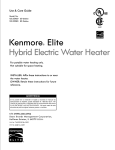

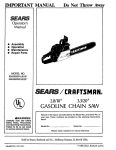
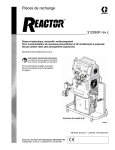
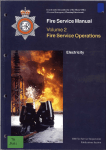
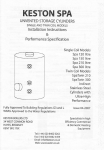
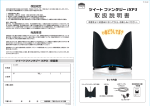
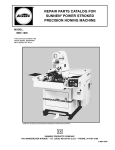

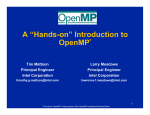
![10780-90006 - 10780A Laser Receiver for 5501A [Prefix 1948] (Mar](http://vs1.manualzilla.com/store/data/006009643_1-6e2f54ebb2199ef6df634558ba4c1bb6-150x150.png)
